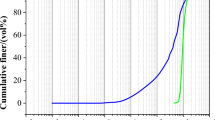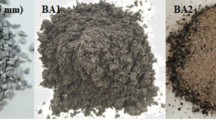Abstract
In this scientific investigation, we explore the potential of bottom ash from municipal solid waste incineration (MSWI), hereafter referred to as BA-MSWI, as an alternative to natural aggregates in epoxy mortar production. BA-MSWI bottom ash represents a prevalent environmental issue due to its excessive production, and its use in sustainable applications could help reduce the demand for natural aggregates. We conducted experiments by replacing natural sand with varying proportions of BA-MSWI (30–100%) and using epoxy resin (15–20%) as a binder. A packing density model was employed to optimize mixture compactness, calculate total porosity, and determine the required amount of resin. The results indicate a decrease in compressive strength and flexural strength when BA-MSWI is incorporated, but they enhance the thermal properties of the mortar. Importantly, the increased proportion of epoxy resin compensates for the loss of strength induced by the addition of BA-MSWI. From an environmental perspective, this research opens up possibilities for the utilization of BA-MSWI in various construction applications.










Similar content being viewed by others

References
Kaza S, Yao LC, Bhada-Tata P, Van Woerden F (2018) What a waste 2.0: a global snapshot of solid waste management to 2050. Washington, DC: World Bank. https://doi.org/10.1596/978-1-4648-1329-0
Upgraded Mineral Sand Fraction from MSWI Bottom Ash: An Alternative Solution for the Substitution of Natural Aggregates in Concrete Applications - ScienceDirect. https://www.sciencedirect.com/science/article/pii/S1877705817317897. Accessed 4 Mar 2021
del Valle-Zermeño R, Formosa J, Chimenos JM et al (2013) Aggregate material formulated with MSWI bottom ash and APC fly ash for use as secondary building material. Waste Manage 33:621–627. https://doi.org/10.1016/j.wasman.2012.09.015
Chimenos JM, Fernández AI, Miralles L et al (2003) Short-term natural weathering of MSWI bottom ash as a function of particle size. Waste Manage 23:887–895. https://doi.org/10.1016/S0956-053X(03)00074-6
Clavier KA, Watts B, Liu Y et al (2019) Risk and performance assessment of cement made using municipal solid waste incinerator bottom ash as a cement kiln feed. Resour Conserv Recycl 146:270–279. https://doi.org/10.1016/j.resconrec.2019.03.047
Oehmig WN, Roessler JG, Blaisi NI, Townsend TG (2015) Contemporary practices and findings essential to the development of effective MSWI ash reuse policy in the United States. Environ Sci Policy 51:304–312. https://doi.org/10.1016/j.envsci.2015.04.024
Smorokov A, Kantaev A, Bryankin D et al (2023) Low-temperature method for desiliconization of polymetallic slags by ammonium bifluoride solution. Environ Sci Pollut Res 30:30271–30280. https://doi.org/10.1007/s11356-022-24230-y
Matsukevich I, Kulinich N, Romanovski V (2022) Direct reduced iron and zinc recovery from electric arc furnace dust. J Chem Technol Biotechnol 97:3453–3458. https://doi.org/10.1002/jctb.7205
Keulen A, van Zomeren A, Harpe P et al (2016) High performance of treated and washed MSWI bottom ash granulates as natural aggregate replacement within earth-moist concrete. Waste Manage 49:83–95. https://doi.org/10.1016/j.wasman.2016.01.010
Jurič B, Hanžič L, Ilić R, Samec N (2006) Utilization of municipal solid waste bottom ash and recycled aggregate in concrete. Waste Manag 26:1436–1442. https://doi.org/10.1016/j.wasman.2005.10.016
Tang P, Florea MVA, Spiesz P, Brouwers HJH (2016) Application of thermally activated municipal solid waste incineration (MSWI) bottom ash fines as binder substitute. Cem Concr Compos 70:194–205. https://doi.org/10.1016/j.cemconcomp.2016.03.015
Kamarou M, Moskovskikh D, Chan HL et al (2023) Low energy synthesis of anhydrite cement from waste lime mud. J Chem Technol Biotechnol 98:789–796. https://doi.org/10.1002/jctb.7284
Zalyhina V, Cheprasova V, Romanovski V (2024) Recycling of fine fraction of spent foundry sands into fireclay bricks. J Mater Cycles Waste Manag 26:322–330. https://doi.org/10.1007/s10163-023-01825-2
Singh A, Zhou Y, Gupta V, Sharma R (2022) Sustainable use of different size fractions of municipal solid waste incinerator bottom ash and recycled fine aggregates in cement mortar. Case Stud Constr Mater 17:e01434. https://doi.org/10.1016/j.cscm.2022.e01434
Maherzi W, Ennahal I, Benzerzour M et al (2020) Study of the polymer mortar based on dredged sediments and epoxy resin: effect of the sediments on the behavior of the polymer mortar. Powder Technol 361:968–982. https://doi.org/10.1016/j.powtec.2019.10.104
Ennahal I, Maherzi W, Mamindy-Pajany Y et al (2019) Eco-friendly polymers mortar for floor covering based on dredged sediments of the north of France. J Mater Cycles Waste Manag 21:861–871. https://doi.org/10.1007/s10163-019-00843-3
Ennahal I, Maherzi W, Benzerzour M et al (2021) Performance of lightweight aggregates comprised of sediments and thermoplastic waste. Waste Biomass Valor 12:515–530. https://doi.org/10.1007/s12649-020-00970-1
Barczewski M, Sałasińska K, Szulc J (2019) Application of sunflower husk, hazelnut shell and walnut shell as waste agricultural fillers for epoxy-based composites: a study into mechanical behavior related to structural and rheological properties. Polym Testing 75:1–11. https://doi.org/10.1016/j.polymertesting.2019.01.017
Tasnim S, Shaikh FUA, Sarker PK (2021) Mechanical properties and microstructure of lightweight polymer composites containing mono and hybrid fillers sourced from recycled solid wastes. Constr Build Mater 277:122369. https://doi.org/10.1016/j.conbuildmat.2021.122369
Sahu R, Gupta MK, Chaturvedi R et al (2020) Moisture resistant stones waste based polymer composites with enhanced dielectric constant and flexural strength. Compos B Eng 182:107656. https://doi.org/10.1016/j.compositesb.2019.107656
Jaya Krishna K, Jayakumar V, Bharathiraja G (2020) Mechanical analysis of medical waste reinforced polymer composite. Materials Today: In Proceedings 22:pp 473–476. https://doi.org/10.1016/j.matpr.2019.07.722
Kou S-C, Poon C-S (2013) A novel polymer concrete made with recycled glass aggregates, fly ash and metakaolin. Constr Build Mater 41:146–151. https://doi.org/10.1016/j.conbuildmat.2012.11.083
Tiwari S, Gehlot C, Srivastava D 2020 Synergistic influence of CaCO3 nanoparticle on the mechanical and thermal of fly ash reinforced epoxy polymer composites. Materials Today: In Proceedings. https://doi.org/10.1016/j.matpr.2020.06.205
Krishna MP, kireeti MP, Krishna MR, et al (2018) Mechanical properties of fly ash/ sawdust reinforced epoxy hybrid composites. Materials Today: In Proceedings 5:pp 13025–13030. https://doi.org/10.1016/j.matpr.2018.02.288
Keong GC, Mohd Walad MHB, Xiong OW et al (2017) A study on mechanical properties and leaching behaviour of municipal solid waste (MSW) incineration ash/epoxy composites. Energy Procedia 143:448–453. https://doi.org/10.1016/j.egypro.2017.12.780
Goh CK, Valavan SE, Low TK, Tang LH (2016) Effects of different surface modification and contents on municipal solid waste incineration fly ash/epoxy composites. Waste Manage 58:309–315. https://doi.org/10.1016/j.wasman.2016.05.027
Ledee V, De Larrard F, Sedran T, Brochu F (2004) Essai de compacite des fractions granulaires a la table a secousses : Mode operatoire. techniques ET Methodes DES Laboratoires DES Ponts ET Chaussees - Methode D’Essai. Institut Francais des Sciences et Technologies des Transports, de l'Aménagement et des Réseaux (IFSTTAR). ISBN: 2-7208-0373-1
Nóvoa PJRO, Ribeiro MCS, Ferreira AJM (2004) Mechanical behaviour of cork-modified polymer concrete. Mater Sci Forum 455–456:805–809. https://doi.org/10.4028/www.scientific.net/MSF.455-456.805
Nguyen HG, Ortola S, Ghorbel E (2013) Micromechanical modelling of the elastic behaviour of polymer mortars. Eur J Environ Civ Eng 17:65–83. https://doi.org/10.1080/19648189.2012.739787
Benzannache N, Bezazi A, Bouchelaghem H et al (2018) Statistical analysis of 3-point bending properties of polymer concretes made from marble powder waste, sand grains, and polyester resin. Mech Compos Mater 53:781–790. https://doi.org/10.1007/s11029-018-9703-2
Carrión F, Montalbán L, Real JI, Real T (2014) Mechanical and physical properties of polyester polymer concrete using recycled aggregates from concrete sleepers. Sci World J 2014:1–10. https://doi.org/10.1155/2014/526346
Golestaneh M, Amini G, Najafpour GD, Beygi MA (2010) Evaluation of mechanical strength of epoxy polymer concrete with silica powder as filler. World Appl Sci J 9:216–220
Bărbuţă M, Harja M, Baran I (2010) Comparison of mechanical properties for polymer concrete with different types of filler. J Mater Civ Eng 22:696–701. https://doi.org/10.1061/(ASCE)MT.1943-5533.0000069
Fu S-Y, Feng X-Q, Lauke B, Mai Y-W (2008) Effects of particle size, particle/matrix interface adhesion and particle loading on mechanical properties of particulate–polymer composites. Compos B Eng 39:933–961. https://doi.org/10.1016/j.compositesb.2008.01.002
Ribeiro MCS, Tavares CML, Figueiredo M et al (2003) Bending characteristics of resin concretes. Mat Res 6:247–254. https://doi.org/10.1590/S1516-14392003000200021
Yemam DM, Kim B-J, Moon J-Y, Yi C (2017) Mechanical properties of epoxy resin mortar with sand washing waste as filler. Materials 10:246. https://doi.org/10.3390/ma10030246
Ribeiro MCS, Reis JML, Ferreira AJM, Marques AT (2003) Thermal expansion of epoxy and polyester polymer mortars—plain mortars and fibre-reinforced mortars. Polym Test 22:849–857. https://doi.org/10.1016/S0142-9418(03)00021-7
Wong CP, Bollampally RS (1999) Thermal conductivity, elastic modulus, and coefficient of thermal expansion of polymer composites filled with ceramic particles for electronic packaging. J Appl Polym Sci 74:3396–3403. https://doi.org/10.1002/(SICI)1097-4628(19991227)74:14%3c3396::AID-APP13%3e3.0.CO;2-3
Chow TS (1978) Effect of particle shape at finite concentration on thermal expansion of filled polymers. J Polym Sci Polym Phys Ed 16:967–970. https://doi.org/10.1002/pol.1978.180160603
Guo Y, Ruan K, Shi X et al (2020) Factors affecting thermal conductivities of the polymers and polymer composites: a review. Compos Sci Technol 193:108134. https://doi.org/10.1016/j.compscitech.2020.108134
Prolongo SG, Gude MR, Ureña A (2012) Water uptake of epoxy composites reinforced with carbon nanofillers. Compos Appl Sci Manuf 43:2169–2175. https://doi.org/10.1016/j.compositesa.2012.07.014
Dibenedetto AT, Wambach AD (1972) The fracture toughness of epoxy-glass bead composites. Int J Polym Mater Polym Biomater 1:159–173. https://doi.org/10.1080/00914037208082114
Author information
Authors and Affiliations
Corresponding author
Additional information
Publisher's Note
Springer Nature remains neutral with regard to jurisdictional claims in published maps and institutional affiliations.
Rights and permissions
Springer Nature or its licensor (e.g. a society or other partner) holds exclusive rights to this article under a publishing agreement with the author(s) or other rightsholder(s); author self-archiving of the accepted manuscript version of this article is solely governed by the terms of such publishing agreement and applicable law.
About this article
Cite this article
Ennahal, I., Abriak, Y., Benzerzour, M. et al. Utilizing bottom ash from municipal solid waste incineration as a sustainable replacement for natural aggregates in epoxy mortar production: a feasibility study. J Mater Cycles Waste Manag (2024). https://doi.org/10.1007/s10163-024-01956-0
Received:
Accepted:
Published:
DOI: https://doi.org/10.1007/s10163-024-01956-0



